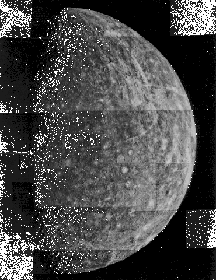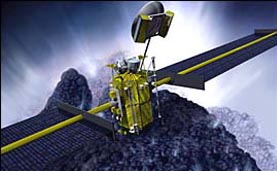NASA Names Next Two Discovery Missions
News story originally written on July 9, 1999
NASA has chosen the next two projects that will join a special series called the Discovery Program. This program specializes in low cost, scientific projects. Out of 26 possible projects, Messenger (the Mercury Surface, Space Environment, Geochemistry and Ranging), and Deep Impact missions were chosen. Both are scheduled to begin early in the next century.
Messenger will begin its long journey to the innermost planet of our Solar System, Mercury, in 2004. It will be loaded with special instruments to investigate the surface and interior of the tiny planet. Probably the most important goal of the mission is the search for ice near the polar craters. Johns Hopkins University will be in charge of the program, which is estimated at $286 million. Messenger will be the first mission to Mercury since the Mariner 10 flyby in 1975.
"These low-cost missions are both fantastic examples of the creativity of the space science community," said Dr. Edward Weiler, associate administrator for space science at NASA Headquarters in Washington, DC. "Messenger is a flagship-quality effort that, in tandem with a separate Pluto mission, enables us to seize the opportunity to complete our historic initial reconnaissance of the Solar System."
Deep Impact is the other project that will join the Discovery Program. The mission is simple, send a large spacecraft to crash into Comet Tempel 1. Scientists can then study the core of the comet. Moving at speeds up to 22,300 MPH, the copper projectile will collide with the comet on July 4, 2005. NASA's Jet Propulsion Laboratory will run the project, which is estimated at $240 million.
"Deep Impact presents a special chance to do some truly unique science, and it is a direct complement to the other two comet missions already in the Discovery Program," said Dr. Weiler. These two missions are called Stardust and Comet Nucleus Tour (CONTOUR). Stardust will gather comet dust and bring it back to Earth, while CONTOUR will fly by three different comets.
A similar project that would have landed a probe on Tempel 1 was recently scrapped by NASA because of a lack of funding. There are currently six projects working under the Discovery Program. Two of them have already completed their primary missions. Lunar Prospector has successfully mapped the Moon's composition and gravity field, and Mars Pathfinder landed on the Red Planet and took several photographs.















